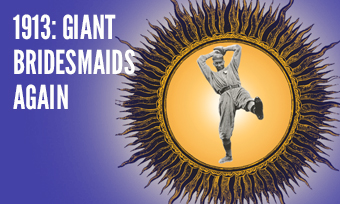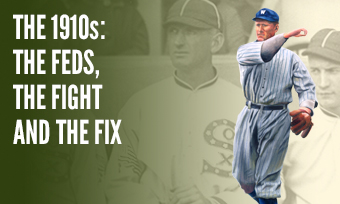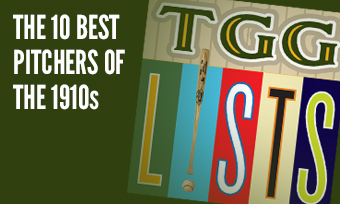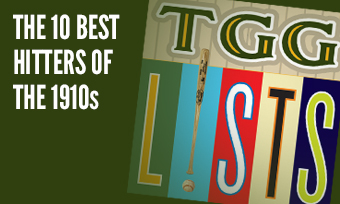The Yearly Reader
Leaders and Honors, 1913
Our list of baseball’s top 10 hitters and pitchers in both the American League and National League for the 1913 baseball season, as well as the awards and honors given to the game’s top achievers of the year.
The National League’s Top 10 Hitters, 1913
Bold type in brick red indicates league leader.
1. Gavvy Cravath, Philadelphia
Key Numbers: .341 average, 179 hits, 34 doubles, 14 triples, 19 home runs, 128 RBIs, .568 slugging percentage.
A late bloomer at 32, Cravath took over for Wildfire Schulte as baseball’s pre-Babe Ruth super-slugger.
2. Vic Saier, Chicago
Key Numbers: .289 average, 94 runs, 21 triples, 14 home runs, 92 RBIs, 62 walks, 26 stolen bases.
Not only did Frank Chance’s replacement at first base mushroom his home run totals from two the year before—he hit 11 just at home—but his 21 triples tied a Cubs record which remains today.
3. Sherry Magee, Philadelphia
Key Numbers: .306 average, 92 runs, 36 doubles, 11 home runs.
Now in his 10th year with the Phillies, Magee remained one of the team’s best, but one of the least liked among his home fans—because, Philadelphia.
4. Heinie Zimmerman, Chicago
Key Numbers: .313 average, 28 doubles, 12 triples, 9 home runs, 95 RBIs.
A dropdown from 1912, but it’s hard to duplicate a Triple Crown performance.
5. Jim Viox, Pittsburgh
Key Numbers: .317 average, 86 runs, 32 doubles, 8 triples, 64 walks.
In his first—and best—of only three seasons at the major league level, Viox became the first Pirate other than Honus Wagner to lead the team in hitting since 1902.
6. Hans Lobert, Philadelphia
Key Numbers: .300 average, 98 runs, 172 hits, 28 doubles, 11 triples, 7 home runs, 41 stolen bases.
With an uncanny resemblance to Honus Wagner—he was even nicknamed Honus—Lobert put up numbers that nearly evoked those of the Flying Dutchman.
7. Max Carey, Pittsburgh
Key Numbers: .277 average, 620 at-bats, 99 runs, 23 doubles, 10 triples, 61 stolen bases.
Carey won his first of 10 basestealing titles as his success rate jumped out among the typical lot stuck at 50%.
8. Tommy Leach, Chicago
Key Numbers: .287 average, 99 runs, 23 doubles, 10 triples, 77 walks.
In a somewhat vintage effort at age 35, Leach finished his first full year at Chicago topping the NL charts in runs for the second time in his career.
9. Larry Doyle, New York
Key Numbers: .280 average, 5 home runs, 73 RBIs, 38 stolen bases.
On a Giants lineup from which no one player statistically stood out—good or bad—Doyle still held the advantage once all the metrics were figured in.
10. Jake Daubert, Brooklyn
Key Numbers: .350 average, 76 runs, 178 hits, 25 stolen bases.
Daubert won the first of two NL batting titles and a Chalmers auto, given to the NL MVP—all despite his team’s sixth-place finish.
The American League’s Top 10 Hitters, 1913
1. Frank Baker, Philadelphia
Key Numbers: .337 average, 116 runs, 190 hits, 34 doubles, 9 triples, 12 home runs, 117 RBIs, 34 stolen bases.
Baker set a career high in his nickname (“Home Run”) and contributed in so many other ways, but MVP voters didn’t even get him the most votes on his team (see Eddie Collins, below).
2. Joe Jackson, Cleveland
Key Numbers: .373 average, 109 runs, 197 hits, 39 doubles, 17 triples, 7 home runs, 71 RBIs, 80 walks, .551 slugging percentage.
Shoeless Joe never won a batting title; he finished second behind Ty Cobb for the third straight year.
3. Ty Cobb, Detroit
Key Numbers: 122 games, .390 average, 18 doubles, 16 triples, 67 RBIs, 51 stolen bases, .466 on-base percentage.
Holding out through most of April for higher wages didn’t handicap Cobb’s productivity once he did return to the field.
4. Tris Speaker, Boston
Key Numbers: .363 average, 94 runs, 189 hits, 35 doubles, 22 triples, 71 RBIs, 65 walks, 46 stolen bases.
Don’t blame Spoke for the Red Sox’ fall from championship grace in 1913; the all-time leader in doubles set a personal high in triples.
5. Eddie Collins, Philadelphia
Key Numbers: .345 average, 125 runs, 184 hits, 13 triples, 73 RBIs, 85 walks, 55 stolen bases.
Steady Eddie, who amazingly never copped a batting crown of his own (at least, ceremoniously—see Ty Cobb, 1914), still impressed with yet another .340-something effort.
6. Sam Crawford, Detroit
Key Numbers: .317 average, 609 at-bats, 193 hits, 32 doubles, 23 triples, 9 home runs, 83 RBIs.
As he neared his mid-30s, Crawford remained Cobb’s faithful sidekick in the Detroit lineup; without both of them, the Tigers hit just .244.
7. Clyde Milan, Washington
Key Numbers: .301 average, 92 runs, 9 triples, 75 stolen bases.
“Deerfoot” ran his two-year total for stolen bases to a whopping 163 while hitting over .300 for the third straight year.
8. Stuffy McInnis, Philadelphia
Key Numbers: .324 average, 176 hits, 30 doubles, 90 RBIs.
His defensive excellence at first base starting to hit full flower, McInnis had to continually remind baseball fans that he was a pretty good hitter, too.
9. Rube Oldring, Philadelphia
Key Numbers: .283 average, 101 runs, 27 doubles, 9 triples, 71 RBIs, 40 stolen bases.
Oldring got back into shape (both physically and mentally) after being suspended by the A’s late in 1912, making the most of a career-high 137 games.
10. Burt Shotton, St. Louis
Key Numbers: .297 average, 105 runs, 8 triples, 99 walks, 43 stolen bases.
The future manager did what he could to spark a bad Browns team from the top of the order, but more importantly began to build a fruitful relationship with future baseball mastermind Branch Rickey.
The National League’s Top 10 Pitchers, 1913
1. Christy Mathewson, New York
Key Numbers: 2.06 ERA, 25 wins, 11 losses, 306 innings, 21 walks.
Accurate as ever, Mathewson piled up more wins than walks; he also became the first NL pitcher in 10 years to win the ERA crown with a figure over the 2.00 mark.
2. Babe Adams, Pittsburgh
Key Numbers: 2.15 ERA, 21 wins, 10 losses, 313.2 innings.
Adams’ innings count peaked by eclipsing 300 for the sole time in his career.
3. Rube Marquard, New York
Key Numbers: 2.50 ERA, 23 wins, 10 losses, 288 innings.
The gifted lefty capped the salad days portion of his career with his last of three straight 20-win campaigns. He’d lose 20 the next season.
4. Jeff Tesreau, New York
Key Numbers: 2.17 ERA, 22 wins, 13 losses, 38 starts, 282 innings.
The right-hander’s follow-up to his rookie campaign was superb in its own right and gave the Giants three 20-game winners.
5. Tom Seaton, Philadelphia
Key Numbers: 2.60 ERA, 27 wins, 12 losses,52 appearances, 322.1 innings, 136 walks, 168 strikeouts.
Arguably the NL’s first knuckleballer, Seaton looked every bit as good as teammate Pete Alexander before making a wrong turn into the Federal League.
6. Al Demaree, New York
Key Numbers: 2.21 ERA, 13 wins, 4 losses, .765 win percentage.
Often described as having a pitching motion similar to that of a shotput athlete, the 28-year-old rookie could have made it four 20-game winners on the Giants’ staff had he been given more starts.
7. Hank Robinson, Pittsburgh
Key Numbers: 2.38 ERA, 14 wins, 9 losses.
Another under-the-radar season for the quasi-reliever (43 appearances, 22 starts) apparently wasn’t good enough for the Pirates to lock onto him; they made him part of a massive postseason trade with the Cardinals.
8. Larry Cheney, Chicago
Key Numbers: 2.57 ERA, 21 wins, 14 losses, 11 saves, 54 appearances, 305 innings, 19 wild pitches.
The Cubs’ ace was almost better as a reliever, coming out of the bullpen 18 times with a 5-0 record, 2.02 ERA and league-leading 11 saves.
9. Pete Alexander, Philadelphia
Key Numbers: 2.79 ERA, 22 wins, 8 losses, .733 win percentage, 47 appearances, 9 shutouts, 306.1 innings.
Alexander had one of the more muted efforts of his young career despite busting out to a 10-0 start.
10. Ad Brennan, Philadelphia
Key Numbers: 2.39 ERA, 14 wins, 12 losses.
The southpaw’s one shining season in the majors before jumping to the Federal League counted among his highlights a punch-out of Giants manager John McGraw.
The American League’s Top 10 Pitchers, 1913
1. Walter Johnson, Washington
Key Numbers: 1.14 ERA, 36 wins, 7 losses, .837 win percentage, 29 complete games, 346 innings, 11 shutouts, 243 strikeouts, 38 walks.
How incredible was the Big Train? He allowed just one run over his first 53.2 innings of the year.
2. Reb Russell, Chicago
Key Numbers: 1.90 ERA, 22 wins, 16 losses, 52 appearances, 8 shutouts, 316.2 innings, 4 balks.
Thought to be Pacific Coast League-bound at the start of the year, the 24-year-old rookie barely made the White Sox and became their surprise premier starter by hurling an AL rookie record-tying eight shutouts.
3. Jim Scott, Chicago
Key Numbers: 1.90 ERA, 20 wins, 21 losses, 38 starts, 312.1 innings.
Not only did Scott share Russell’s duties as White Sox workhorse, he also shared the angst of not getting enough support with less than three runs per start. Hence, 21 losses.
4. Eddie Cicotte, Chicago
Key Numbers: 1.58 ERA, 18 wins, 12 losses, 268 innings.
The future Black Sox participant solidified his place in the White Sox rotation after four-plus years of relative frustration with the Red Sox; with fellow teammates Russell and Scott (above), Cicotte helped make it 2-3-4 in the ERA race after Johnson.
5. Chief Bender, Philadelphia
Key Numbers: 2.21 ERA, 21 wins, 10 losses, 48 appearances, 21 starts, 13 saves.
Used more as reliever than starter, Bender become an early version of a legitimate closer and still managed to win 20 games for the second (and last) time of his career.
6. Cy Falkenberg, Cleveland
Key Numbers: 2.22 ERA, 23 wins, 10 losses, 276 innings, 13 wild pitches.
After scraping the .500 mark for years, Falkenberg finally got a breakthrough in Cleveland—though some credited an illegal emery ball for his success.
7. Eddie Plank, Philadelphia
Key Numbers: 2.60 ERA, 18 wins, 10 losses, 7 shutouts.
In his 14th season at Philadelphia, the last active original Athletic* remained one of the best—even as he turned 38 at mid-season. (*-Harry Davis was still with the A’s in 1914 as he was in 1901, but he broke away to spend a year at Cleveland.)
8. Willie Mitchell, Cleveland
Key Numbers: 1.91 ERA, 14 wins, 8 losses.
With a better ERA than teammates Cy Falkenberg (above) and Vean Gregg (below), Mitchell had one of the more satisfying years of an otherwise checkered career.
9. Ray Collins, Boston
Key Numbers: 2.63 ERA, 19 wins, 8 losses.
After three years of struggling to stay above .500 despite solid pitching and a solid group of hitters supposedly backing him, Collins finally got his just due in victories.
10. Vean Gregg, Cleveland
Key Numbers: 2.24 ERA, 20 wins, 13 losses, 285.2 innings, 124 walks.
Gregg won at least 20 for the third straight year, struck out Ty Cobb three times in one game, ran off a 32-inning scoreless streak and, in a postseason exhibition against Pittsburgh, struck out 19 in a 13-inning win. At 28, he’d only win 29 more games in his major league career.










